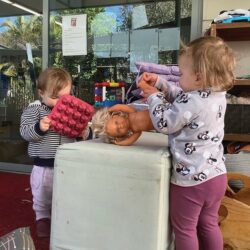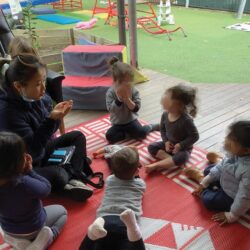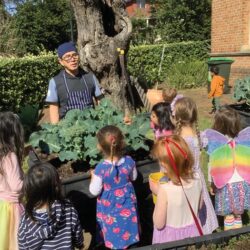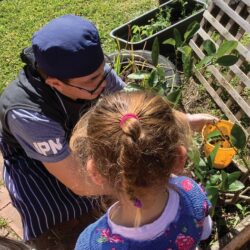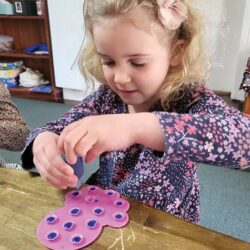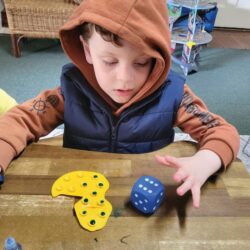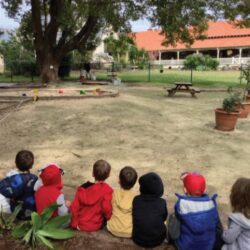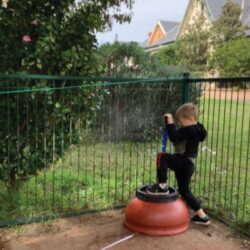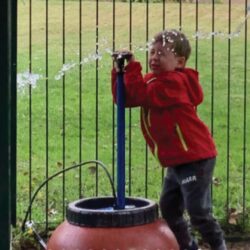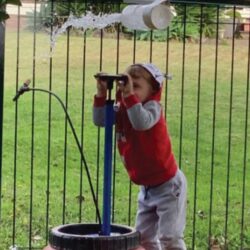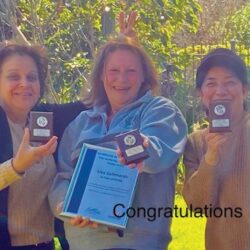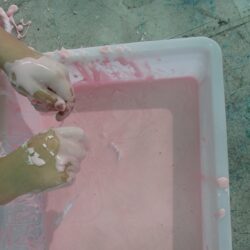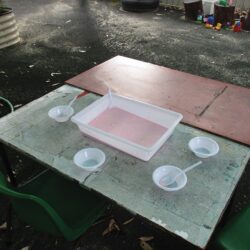Gorton House
Infants
Story by Educator Chamani
The children in the Gorton House babies room have shown great interest in engaging in pretend play during the last couple of weeks. They have started to spend more time in the kitchen/home corner than usual. Caring for babies, pretending to cook, baking, getting groceries, and pretending to feed family and friends has become a big part of this play. After having morning tea, most of the children come together, carrying small baskets all around the room and collecting items that can potentially be their groceries, utensils and clothes etc. There are moments when I have seen them hold hands and go for walks together to get things done. To support this interest, sometimes we also move the kitchen corner outdoors. It is so wonderful to see how these little children are coming together to explore their interests and to develop many skills, such as:
- social and emotional skills
- language and communication skills
- thinking, learning, and problem-solving skills
- physical skills.
Also, through pretend play, children learn to do things like negotiate, consider others’ perspectives, transfer knowledge from one situation to another, delay gratification, balance their own ideas with those of others, develop a plan and act on it, explore symbolism, express and listen to thoughts and ideas, assign tasks and roles and, most importantly, act with empathy and respect toward one another. This is something that children learn through play, which is widely recognised as an essential method of learning. We have so much fun watching children sharing their knowledge and engaging in play.
Toddlers
Story by Educator Demi
Recently in Gorton House toddlers, we have been having lots of discussions about our feelings and emotions. We have also started to introduce ‘mindfulness’ to the children during gathering time, where we sit together, sing and dance, settle our bodies and minds down, discuss questions around feelings and do some breathing exercises. Sometimes we listen to some calm music to bring our awareness of the world around us.
Feelings
During our discussions, lots of questions have been raised:
- what kinds of emotions have we have experienced?
- what do these look like on our faces?
- if … happened, what would you feel?
- what would you do when you are feeling …?
- what would you do when you see your friend is feeling …?
During our gathering time the children share their understanding of feelings and emotions, and the strategies they feel are useful and meaningful to share with their peers. I’m excited to see some children in Gorton House toddlers are able to say “I’m feeling sad, I need some space”. They are able to name their feelings, and verbally communicate their feeling and their needs. When they see an upset peer, they offer a cuddle or a gentle rub on their back, saying “Can I give you a cuddle?” or say “You will be ok, mummy and daddy are coming soon”.
The children are showing their awareness of the world around them, and developing their skills in showing care and empathy to peers with respect.
Breathing
To make the breathing exercises fun, there are lots of stories we have added to them. We pretend we are smelling a flower, that we are a very sleepy bear who is snoring, or we pretend we are drinking hot chocolate and making an “Ummm” sound. We also do ‘yawning’, and even count when we are breathing in and out. (Ideas come from the YouTube playlist ‘Mindful moments for Kids’ by Kira Wiley). Our children love it. Some of them close their eyes, some move their arms up and down while breathing in and out and some smile while they breathe. Most of them comment they feel calm, nice and happy after the breathing exercise. We have also introduced the breathing technique to our children to better support them during big emotions, and our educators stay alongside the children, going through the breathing process with them.
When possible, we also invite our children to lie down in a comfortable spot, play some calm music, and guide them to look at the trees, the birds, the sky, and to feel the wind and to listen to the birds and the wind. This helps to bring their awareness of the world around them, and to feel nice by being within and a to part of our environment.
Preschool
Story by Educator Nicky
The Gorton House preschoolers have been avid carers of their worm farm and they actively participate in recycling food scraps each day. Very often we pause and watch the worms, a whole little ecosystem containing creatures working to eat through the scraps, turning them into compost. Often the children seek to very gently hold the worms and they watch in delight and intrigue as their little bodies move and slither.
Questions arise—where are their mouths? Do they have bones? Why do we feed them? And so, we learn so much, particularly in relation to how important worms are to the health of the earth and in turn, how they support humans, by keeping the soil rich and healthy so food will continue to grow.
On an earlier visit to the lawn, we stopped to investigate the vegetables and herbs that our Chef Charoen had planted in the Kitchen Garden. Some we recognised—the broccoli, and the mint—but others we didn’t. As we discussed the needs of these plants to continue thriving, and recalled the rich compost our worms were creating, we had a thought—would Charoen like some of our compost to help fertilise these plants? So, we asked him. Charoen was so excited to hear from us and he met us near the garden—us with our bucket full of rich compost and Charoen with the happiest and most welcoming of smiles.
The children had many questions and Charoen was able to give them answers. Why are there egg shells in the soil? (They are high in nutrients and help the plants grow). What plant is growing on this vine? (Charoen told us they were going to be chokos). What does he do with the lemongrass? (Charoen uses it to make stock for their lunches). The children shared knowledge on the little flowers growing on the lemon tree—how these will be pollinated by bees and will grow into lemons. Together they spotted that several lemons were already growing, meaning they had already been pollinated. I watched on as the children and Charoen engaged and worked together to care for the plants and thought how lucky we are to have such a sense of community, and access to so much within the huge grounds at The Infants’ Home, as well as the opportunity for the children to not only learn directly from Charoen, but to also contribute meaningfully to the garden they pass each day, and which they know contributes to their meals.
The interdependence we have with each other, and also with the earth is so important—it sustains us, and we also try to sustain it.
More excitement was to come—Charoen paused again by the broccoli and told us that it was almost due to be picked and he asked if we would like to return next week and help him do that. Well, of course we all said yes, so the date and time has been set, and it sounds like we might be eating broccoli sometime next week!!!
Johnson House
Preschool
Story by Senior Occupational Therapist Justine
At Johnson House preschool we have been working hard on refining our fine motor skills. The children have been enjoying using these dropper bottles (pictured below). We used them alongside some bath decorations with the suction cups on the underside. With a roll of the dice, the idea was to squeeze the dropper bottle and fill up the number of suction caps that corresponded with the number on the dice!
The great thing about these dropper bottles is that they promote: hand separation (separating the thumb, index, and middle fingers from the rest of the digits); hand arch development (open web space); controlled finger movements; motor planning; muscle strength; and hand-eye coordination. These skills impact on the ability to master other ‘fine motor’ tasks such as dressing, eating, writing, drawing and cutting.
As for the dice, it was a fun and informal way to introduce numeracy, including number recognition, counting and patterns. We know that when children are exposed to literacy and numeracy learning through hands-on, practical and play-based experiences, they are more likely to engage meaningfully and successfully with these concepts.
Robinson House
Story by Educator Andrew
Today we continued experimenting with rockets as part of our STEAM project. Over the past two weeks we have looked at a number of ways to propel our rockets, and also a number of ways of measuring the distance they’ve travelled.
For today’s experiment we combined two of our favourite experiments so far (the zip-line rocket and the bicycle pump rocket) to see just how far we could make them travel.
Our rockets were loaded up with approximately 200ml of water and plugged with the cork and bicycle pump rig we built last week for our vertical launches. Today we also needed to secure our rockets to the rope using the PVC pipe and gaffer tape (as we did with the bicarbonate of soda and vinegar zip line experiment) for a horizontal test that would allow us to accurately measure just how far we could launch them.
We had a 50m tape measure (which was more than big enough for the job) on the ground, in case the rockets travelled in excess of the 30m rope we were using. This meant that we could get an accurate reading of the exact distance the rocket travelled.
We were invited to pump the rocket—slow and long up and down motions using the full length of the pump appeared to add more bubbles than the shorter and faster motions, and the bottle made a lot more noise. We soon discovered that this was because of the pressure created by extra oxygen being added to the bottle.
We also discovered that the extra pressure inside the bottle meant we needed to add more force to get the pump down to its base—our biceps and core strength were definitely being put to the test!
But with 3-4 really good pumps, our rockets were off, soaring along the rope anywhere from 5.2m to a whopping 28.3m—how exciting!
It was so pleasing to see so many eager scientists engaged in today’s experiment. It would’ve been so hard to wait for our turn (such was the anticipation), but incredibly we all managed to sit and cheer on our peers’ attempts as we waited for our own turn. Congratulations everyone!
Family Day Care Sydney Wide
Story by Educator Support Officer Maureen
Several of our Registered Educators at our Family Day Care Sydney Wide Randwick Hub recently received service awards. Congratulations to Sarah, Fae, Lisa, Mawarni, and Yvonne for 10 years’ service with The Infants’ Home, and to Ilana for 5 years!
We were lucky enough to have Sarah, Lisa and Mawarni join us at our play session yesterday, and we had an impromptu presentation ceremony. Lisa gifted us with a heartfelt and spontaneous speech of gratitude:
“A big thank you to all the families I’ve met over the years who have supported and trusted me to help raise and educate their children. Thank you to all the children who have made this a truly memorable journey and thank you to the children who have made this a very challenging journey and providing me with an abundance of opportunities to grow and develop and seek out ways to make changes to my practices and philosophy. And thank you to the staff, specially my ESO’s Barbara and Maureen, for their continued assistance, advice and encouragement throughout the years. You all made these years possible”.
Community Playgroups
Story by Playgroup Coordinator Rebecca
At Playgroup this week we learnt about non-Newtonian fluids. We did this by playing with Oobleck (a mix of cornstarch and water). A non-Newtonian fluid is a fluid that doesn’t follow the laws and rules of Newton’s viscosity, meaning that it changes its shape and structure to be either a liquid or a solid.
When we tried to squash the Oobleck into a ball, or scoop it up with our fingers, the Oobleck became hard. When we relaxed our hands in the Oobleck we discovered that our hands sank into it. We also discovered that we could make the Oobleck act like slime, and it could ooze from our fingers and hands.
This was a super-fun sensory experience and we can’t wait to do it again!
